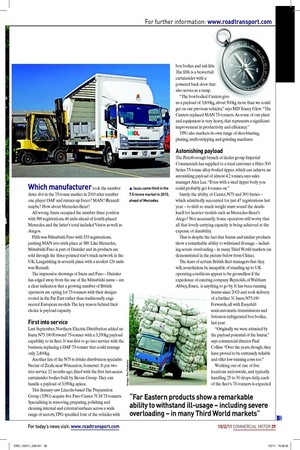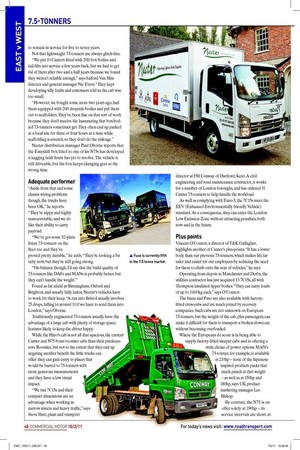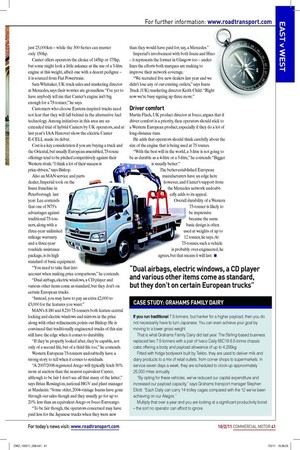Which manufacturer took the number
Page 26

Page 27

Page 28

If you've noticed an error in this article please click here to report it so we can fix it.
three slot in the 7.5-tonne market in 2010 after number one player DAF and runner-up Iveco? MAN? Renault maybe? How about Mercedes-Benz?
All wrong. Isuzu occupied the number three position with 589 registrations, 46 units ahead of fourth-placed Mercedes, and the latter’s total included Varios as well as Ategos.
Fifth was Mitsubishi Fuso with 533 registrations, pushing MAN into sixth place at 389. Like Mercedes, Mitsubishi Fuso is part of Daimler and its products are sold through the three-pointed star’s truck network in the UK. Languishing in seventh place with a modest 126 units was Renault.
The impressive showings of Isuzu and Fuso – Daimler has edged away from the use of the Mitsubishi name – are a clear indication that a growing number of British operators are opting for 7.5-tonners with their designs rooted in the Far East rather than traditionally engineered European models. The key reason behind their choice is payload capacity.
First into service
Last September, Northern Electric Distribution added an Isuzu N75.190 Forward 7.5-tonner with a 3,330kg payload capability to its leet. It was irst to go into service with the business, replacing a DAF 7.5-tonner that could manage only 2,400kg.
Another fan of the N75 is drinks distribution specialist Nectar of Zeals, near Wincanton, Somerset. It put two into service 12 months ago, itted with the irst fast-access curtainsider bodies built by Bevan Group. They can handle a payload of 3,950kg apiece.
This January saw Lincoln-based The Preparation Group (TPG) acquire ive Fuso Canter 7C18 7.5-tonners. Specialising in removing, preparing, polishing and cleaning internal and external surfaces across a wide range of sectors, TPG speciied four of the vehicles with box bodies and tail-lifts.
The ifth is a beavertail curtainsider with a powered back door that also serves as a ramp.
“The box-bodied Canters give us a payload of 3,600kg, about 500kg more than we could get on our previous vehicles,” says MD Tracey Glew. “The Canters replaced MAN 7.5-tonners. As some of our plant and equipment is very heavy, that represents a signiicant improvement in productivity and eficiency.” TPG also markets its own range of shot-blasting, planing, multi-stripping and grinding machines.
Astonishing payload
The Peterborough branch of dealer group Imperial Commercials has supplied to a local customer a Hino 300 Series 7.5-tonne alloy-bodied tipper, which can achieve an astonishing payload of almost 4.2 tonnes, says sales manager Alex Lee. “Even with a steel tipper body you could probably get 4 tonnes on.” Surely the ability of Canter, N75 and 300 Series – which admittedly accounted for just 47 registrations last year – to shift so much weight must sound the deathknell for heavier models such as Mercedes-Benz’s Atego? Not necessarily. Some operators still worry that all that lovely carrying capacity is being achieved at the expense of durability.
That is despite the fact that Isuzus and similar products show a remarkable ability to withstand ill-usage – including severe overloading – in many Third World markets (as demonstrated in the picture below from China).
The fears of certain British leet managers that they will, nonetheless, be incapable of standing up to UK operating conditions appear to be groundless if the experience of catering company Reynolds, of Waltham Abbey, Essex, is anything to go by. It has been running Isuzus since 2003 and took delivery of a further 31 Isuzu N75.190 Forwards, all with Easyshift semi-automatic transmissions and Solomon refrigerated box bodies, last year.
“Originally we were attracted by the payload potential of the Isuzus,” says commercial director Paul Collins. “Over the years, though, they have proved to be extremely reliable and offer low running costs too.” Working out of one of ive locations nationwide, and typically handling 25 to 30 drops daily, each of the leet’s 7.5-tonners is expected to remain in service for ive to seven years.
Not that lightweight 7.5-tonners are always glitch-free.
“We put 10 Canters itted with 20ft box bodies and tail-lifts into service a few years back, but we had to get rid of them after two and a half years because we found they weren’t reliable enough,” says Salford Van Hire director and general manager Nic Evers. “They kept developing silly faults and customers told us the cab was too small.
“However, we bought some more two years ago, had them equipped with 20ft dropside bodies and put them out to scaffolders. They’ve been ine on that sort of work because they don’t receive the hammering that box-bodied 7.5-tonners sometimes get. They often end up parked at a local site for three or four hours at a time while scaffolding is erected, so they don’t do the mileage.” Nectar distribution manager Paul Oborne reports that the Easyshift box itted to one of his N75s has developed a nagging fault Isuzu has yet to resolve. The vehicle is still driveable, but the box keeps changing gear at the wrong time.
Adequate performer
“Aside from that and some chassis wiring problems though, the trucks have been OK,” he reports. “They’re nippy and highly manoeuvrable, and we do like their ability to carry payload.
“We’ve got some 52-plate Isuzu 7.5-tonners on the leet too and they’ve proved pretty durable,” he adds. “They’re looking a bit tatty now, but they’re still going strong.
“On balance though, I’d say that the build quality of 7.5-tonners like DAFs and MANs is probably better, but they can’t handle the weight.” Found as far aield as Birmingham, Oxford and Brighton, and usually fully laden, Nectar’s vehicles have to work for their keep. “A run into Bristol usually involves 25 drops, falling to around 10 if we have to send them into London,” says Oborne.
Traditionally engineered 7.5-tonners usually have the advantage of a large cab with plenty of storage space; features likely to keep the driver happy.
While the Hino’s cab is not all that spacious, the current Canter and N75 boast roomier cabs than their predecessors. Roomier, but not to the extent that they end up negating another beneit the little trucks can offer: they can gain entry to places that would be barred to 7.5-tonners with more generous measurements and they have a low visual impact.
“We run 7C15s and their compact dimensions are an advantage when working in narrow streets and heavy trafic,” says Steve Hart, plant and transport director at FM Conway of Dartford, Kent. A civil engineering and road maintenance contractor, it works for a number of London boroughs, and has ordered 31 Canter 7.5-tonners to help handle the workload.
As well as complying with Euro-5, the 7C15s meet the EEV (Enhanced Environmentally friendly Vehicle) standard. As a consequence, they can enter the London Low Emission Zone without attracting penalties, both now and in the future.
Plus points
Vincent O’Connor, a director of T&K Gallagher, highlights another of Canter’s plus-points. “It has a lower body than our previous 7.5-tonners, which makes life far safer and easier for our employees by reducing the need for them to climb onto the rear of vehicles,” he says.
Operating from depots in Manchester and Derby, the utilities contractor has just acquired 13 7C15s, all with Thompson insulated tipper bodies. “They can carry loads of up to 3,600kg each,” says O’Connor.
The Isuzu and Fuso are also available with factoryitted crew-cabs and are much prized by recovery companies. Such cabs are not unknown on European 7.5-tonners, but the weight of the cab, plus passengers, can make it dificult for them to transport a broken-down car without becoming overloaded.
Where the Europeans do score is in being able to supply factory-itted sleeper cabs and in offering a wide choice of power options. MAN’s 7.5-tonner, for example, is available at 210hp – none of the Japaneseinspired products packs that much punch at that weight – as well as at 150hp and 180hp, says UK product marketing manager Les Bishop.
By contrast, the N75 is on offer solely at 190hp – its service intervals are short, at just 25,000km – while the 300 Series can muster only 150hp.
Canter offers operators the choice of 145hp or 175hp, but some might look a little askance at the use of a 3-litre engine at this weight, albeit one with a decent pedigree – it is sourced from Fiat Powertrain.
Sam Whittaker, UK truck sales and marketing director at Mercedes, says their worries are groundless. “I’ve yet to have anybody tell me that Canter’s engine isn’t big enough for a 7.5-tonner,” he says.
Customers who choose Eastern-inspired trucks need not fear that they will fall behind in the alternative fuel technology. Among initiatives in this area are an extended trial of hybrid Canters by UK operators, and at last year’s IAA Hanover show the electric Canter E-CELL made its debut.
Cost is a key consideration if you are buying a truck and the Oriental, but usually European-assembled, 7.5-tonne offerings tend to be pitched competitively against their Western rivals. “I think a lot of their success is price-driven,” says Bishop.
Also an MAN service and parts dealer, Imperial took on the Isuzu franchise in Peterborough last year. Lee contends that one of N75’s advantages against traditional 7.5-ton ners, along with a three-year unlimited mileage warranty and a three-year roadside assistance package, is its high standard of basic equipment.
“You need to take that into account when making price comparisons,” he contends.
“Dual airbags, electric windows, a CD player and various other items come as standard, but they don’t on certain European trucks.
“Instead, you may have to pay an extra £2,000 to £3,000 for the features you want.” MAN’s 8.180 and 8.210 7.5-tonners both feature central locking and electric windows and mirrors in the price along with other reinements, points out Bishop. He is convinced that traditionally engineered trucks of this size still have the edge when it comes to durability.
“If they’re properly looked after, they’re capable, not only of a second life, but of a third life too,” he contends.
Western European 7.5-tonners undoubtedly have a strong story to tell when it comes to residuals.
“A 2007/2008-registered Atego will typically fetch 30% more at auction than the nearest equivalent Canter, although to be fair I don’t see all that many of the latter,” says Brian Rossington, national HGV and plant manager at Manheim. “Some older, 2004-vintage Isuzus have gone through our sales though and they usually go for up to 20% less than an equivalent Atego or Iveco Eurocargo.
“To be fair though, the operators concerned may have paid less for the Japanese trucks when they were new than they would have paid for, say, a Mercedes.” Imperial’s involvement with both Isuzu and Hino – it represents the former in Glasgow too – underlines the efforts both marques are making to improve their network coverage.
“We recruited ive new dealers last year and we didn’t lose any of our existing outlets,” says Isuzu Truck (UK) marketing director Keith Child. “Right now we’re busy signing up three more.”
Driver comfort
Martin Flach, UK product director at Iveco, argues that if driver comfort is a priority, then operators should stick to a Western European product, especially if they do a lot of long-distance runs.
He adds that operators should think carefully about the size of the engine that is being used at 7.5 tonnes.
“With the best will in the world, a 3-litre is not going to be as durable as a 4-litre or a 5-litre,” he contends. “Bigger is usually better.” The better-established European manufacturers have an edge here however, and Canter’s support from the Mercedes network undoubtedly adds to its appeal.
Overall durability of a Western 7.5-tonner is likely to be impressive because the same basic design is often used at weights of up to 12 tonnes, he says. At 7.5-tonnes, such a vehicle
is probably over-engineered, he agrees, but that means it will last. ■





































